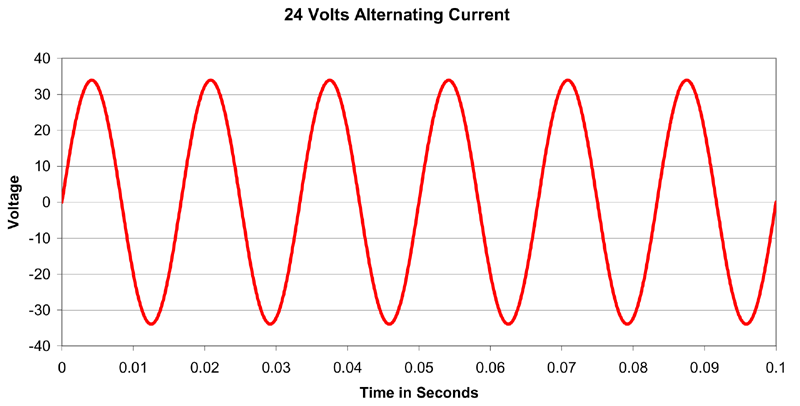24 VAC
If you were to connect an oscilloscope to the output of a 24 VAC transformer, you would see the waveform below. The voltage starts at zero, climbs to a peak, returns to zero, falls to a negative peak and returns to zero; sixty times a second for 60Hz and 50 times a second for 50Hz.

Half-Wave Power Supply
Half-wave power supplies only take power from the AC line during the positive half of the AC waveform. Most controllers use half-wave power supplies.
BAPI’s VC350A EZ and VC350A are half-wave power supplies. Half-wave power supplies may be powered from the same transformer that powers the controller if the controller has a half-wave power supply and the capacity of the transformer is not exceeded.
Transformers used in half-wave power supplies have one of their output leads connected to ground. When powering multiple half-wave power supplies from one transformer, be sure to check for proper transformer connections.
Since only half of the incoming AC is used, half-wave power supplies in 24 VAC systems can only source approximately 1.5 amps of DC maximum.
Full-Wave Power Supply
Full-wave power supplies take power during both halves of the AC waveform. BAPI’s PS17 and PS17CB are full-wave power supplies. The VC2700-STM and VC3000 are available as full-wave or half-wave (specified at time of order).
Transformers used in full-wave power supplies cannot have either of their output leads connected to ground. DO NOT try to power half-wave power supplies and full-wave power supplies from the same transformer. If you do, you will short out the transformer. Half-wave and full-wave power supplies can coexist in the same control system but they must be powered by separate transformers. Since both halves of the incoming AC are used, full-wave power supplies in 24 VAC systems can source approximately 3 amps of DC maximum.
For more information on power supplies, call your BAPI representative or see the Application Note: “Understanding Full and Half Wave Power Supplies”.



